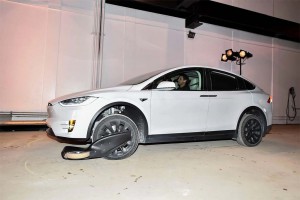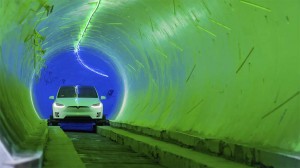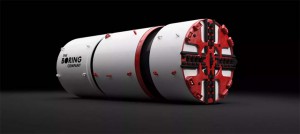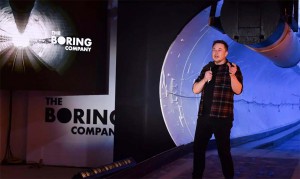If Elon Musk hopes to find a way around L.A.’s famously treacherous traffic he still has a long way to go, but the entrepreneur demonstrated what could be one answer Wednesday night by officially opening the Boring Co.’s first test tunnel in the Los Angeles suburb of Hawthorne.
The 1.14-mile route that begins at the headquarters of SpaceX, one of the companies run by Musk, was anything but smooth, one reporter taken along for a demonstration ride complaining of motion sickness. But the pilot tunnel was simply meant to demonstrate Musk’s belief that “to solve the problem of soul-destroying traffic, roads must go 3D,” according to a post on the Boring Company website.
Capping what has been a tough year for the 47-year-old entrepreneur, the opening of the first tunnel could provide momentum for Musk’s plan to build similar structures across the country. The City of Chicago has already given the Boring Co. a tentative contract to develop an underground link from the city’s downtown to its busy O’Hare Airport. Other proposed projects could see links between Washington D.C. and its suburbs, even one running all the way from the capital to New York City.
(Could a pickup truck be Tesla’s next vehicle? Click Here for the story.)
The concept of digging under traffic was initially dismissed as little more than a fantasy when, two years ago, Musk tweeted that he was “going to build a tunnel boring machine and just start digging.”
But, within months, he revealed a worm-like boring machine that began working on the pilot tunnel located near LAX, the main Los Angeles airport. Boring Co. had previously planned another route parallel to the crowded I-405 freeway but gave that up due to local opposition.
For those who got close enough to look inside the new tunnel they could see that the interior fittings and floor were rough and uneven, Musk admitting to reporters that it was “a little rough around the edges.”
Rough enough that vehicles riding through the tunnel were jounced around rather violently at times, even though they were moving at just 30 to 40 mph, barely a quarter of the speed Musk contends they eventually could operate at.
“We kind of ran out of time” and had trouble with the paving machine used inside the tunnel, Musk explained. The actual tunnel boring machine itself operated at a pace described as only one-fourteenth as fast as a snail, though the goal is to speed that up substantially moving forward. Future tunnels, he insisted, will be “smooth as glass.”
Nonetheless, the South African-born entrepreneur described his own first ride through the tunnel as “epic,” and a “eureka moment,” with Musk quickly realizing, “This thing is going to damn well work.”
(Tesla hustling to build new plant in China. Click Here for the story.)
The fact that Musk’s latest company can take tunnel boring technology to the City of Angels is, in itself, not especially revolutionary. There are highway tunnels all over the world and even a 35-mile rail route under the Swiss Alps that opened early in 2016.
Even from a size perspective, the Boring Co. tunnel is modest, just 12 feet in diameter.
What is really significant is the way Musk proposes using the tunnels he plans to dig. To travel through the pilot route, Tesla’s electric vehicles are outfitted with special guide wheels to keep them centered. Longer-term, Boring expects to develop skateboard-like platforms that would be used to carry a vehicle through the tunnel at speeds of up to 150 mph.
Cars would pull up to a loading point, rather than drive into the tunnels, roll onto one of the skateboards and then descend on an elevator. At the end of their journey they’d be lifted out by another elevator and merge back into surface traffic. Pedestrians and bicyclists, meanwhile, would be able to travel aboard skateboards equipped with cabins.
The project would be funded by a mix of tolls and funding from sponsors, such as the City of Chicago. Musk has estimated a pedestrian would pay about $1 per ride, with cars paying $4.

For the pilot tunnel vehicles used outriggers to keep them steady. In the future, a vehicle would ride atop a special skateboard-like device.
Boring says the initial project cost only about $10 million – perhaps reflected in its relatively unfinished interior. But conventional tunnels can run upwards of $1 billion per mile, depending upon factors such as the sort of ground they have to bore through, their size and what they will be used for. It’s unclear what it would ultimately cost for the project Boring plans to build between downtown Chicago and O’Hare but Musk has promised it will be far less than conventional tunnel companies would charge.
Meanwhile, he said he is confident his company will have the resources to proceed, telling reporters, “We have no problem with investors, we have people hounding us to invest non-stop.”
Ever the entrepreneur, Musk has even suggested Boring Co. could make money by turning the dirt it cuts through into bricks that it could sell.
To underscore the seriousness of the project, Boring unveiled a next-generation tunnel-digging machine on Thursday that should quadruple the speed of the original device.
Musk said he expects the Chicago project – which is now undergoing an environmental study — to be the first to open. He hopes to follow it with what has been dubbed the Dugout Loop that would link the city’s Dodgers Stadium to three subway stations. Longer-term, Musk aims to have a network of tunnels operating across the city in time for the Los Angeles Olympics in 2028.
(Tesla has a smelly Easter egg in its latest infotainment system – a fart app. Click Here for more.)



